
Gilia is a genus of flowering plants in the Polemoniaceae family and is related to phlox. It includes 39 species native to the Americas, ranging from British Columbia to Texas and northern Mexico, and to Ohio, in North America, and from Ecuador and Peru to southern Chile and Argentina in South America. These Western native plants are best sown in sunny, well-draining soil in the temperate and tropical regions of the Americas, where they occur mainly in desert or semi-desert habitats
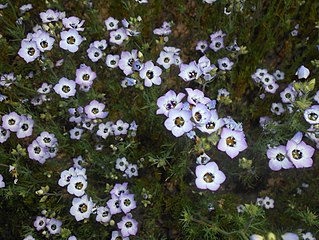
Gilia tricolor is an annual flowering plant in the phlox family (Polemoniaceae).

The annual flowering plant Gilia achilleifolia is known commonly as California gilia, California gily-flower, and blue gilia. It is native to California but grows in other areas of North America where it has been introduced.

Berberis nevinii, known by the common name Nevin's barberry, is a species of flowering shrub in the barberry family.
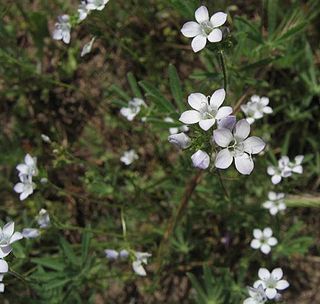
Gilia angelensis is a species of flowering plant in the phlox family known by the common name chaparral gilia. It is native to the coastal hills and mountains of California and Baja California, where it is a member of the chaparral ecosystem., especially in the Transverse Ranges.

Gilia capitata is a species of flowering plant in the phlox family known by the common names blue-thimble-flower, bluehead gilia, blue field gilia, and globe gilia.

Gilia clivorum is a species of flowering plant in the phlox family known by the common names purplespot gilia and many-stemmed gilia. It is native to California and Arizona.
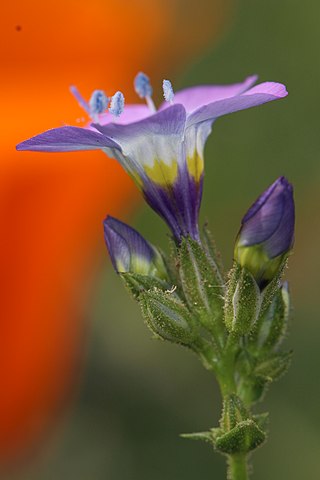
Gilia latiflora is a species of flowering plant in the phlox family known by the common names hollyleaf gilia and broad-flowered gilia. It is endemic to deserts and mountains of southern California and the adjacent margin of Nevada.
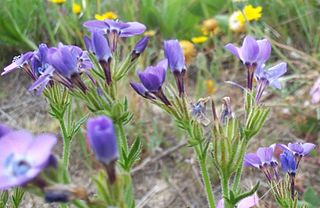
Gilia tenuiflora is a species of flowering plant in the phlox family known by the common name greater yellowthroat gilia. It is endemic to California, where its distribution spans the central coast and coastal mountains, as well as the Channel Islands.

Brickellia nevinii is a species of flowering plant in the family Asteraceae known by the common name Nevin's brickellbush. It is native to southern California and Nevada, where it is an uncommon resident of desert and mountain scrub plant communities.
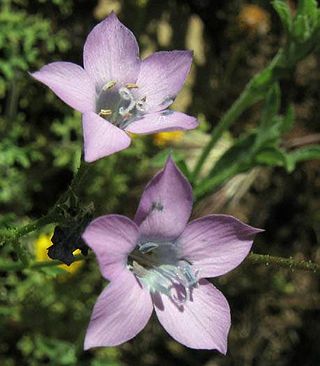
Saltugilia splendens, is a species of flowering plant in the phlox family known by the common names splendid woodland-gilia, Grinnell's gilia and splendid gilia.
Astragalus nevinii is a rare species of milkvetch known by the common name San Clemente Island milkvetch. It is endemic to San Clemente Island, one of the Channel Islands of California. This is perennial herb growing upright 10 to 30 centimetres tall. It is coated in woolly, tangled hairs. Its leaves are up to 8 centimetres long and are made up of many oblong leaflets. The inflorescence is a dense cluster of up to 30 cream-colored flowers, each around 1 centimetre in length. The fruit is a hanging legume pod up to 2 centimetres long which is papery in texture and mostly hairless.
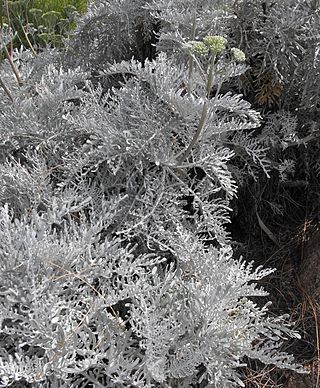
Constancea is a monotypic genus of flowering plants in the family Asteraceae containing the single species Constancea nevinii, which is known by the common name Nevin's woolly sunflower. It is endemic to three of the Channel Islands of California, where it grows in coastal scrub habitat. This is a small shrub or subshrub generally growing up to one or 1.5 meters tall, and taller when an erect form, with a branching, woolly stem. The whitish, woolly oval leaves may be up to 20 centimeters long and are divided into many narrow lobes with edges curled under. The inflorescence is a cluster of 10 to 50 or more small flower heads, each on a short peduncle. The flower head has a center of hairy, glandular, star-shaped yellow disc florets and a fringe of four to nine yellow ray florets, each about 2 millimeters long. The fruit is an achene a few millimeters long with a small pappus at the tip.
Gilia austrooccidentalis is a species of flowering plant in the phlox family known by the common name southwestern gilia. The scientific name is sometimes spelt Gilia austro-occidentalis. It is endemic to the Central Coast Ranges of California, where it grows in local hill and valley habitat.
Gilia diegensis is a species of flowering plant in the phlox family known by the common name coastal gilia.

Gilia leptantha is a species of flowering plant in the phlox family known by the common name fineflower gilia.

Gilia salticola is a species of flowering plant in the phlox family known by the common name salt gilia. It is native to the Sierra Nevada and Modoc Plateau of California and western Nevada, where it grows in volcanic and granitic soils.
The Bonny Doon Ecological Reserve is a nature preserve of 552 acres (2.23 km2) in the Santa Cruz Mountains of California, United States. The reserve protects several rare and endangered plant and animal species within an area known as the Santa Cruz Sandhills, an ancient seabed containing fossilized marine animals.
Gilia yorkii is a rare species of flowering plant in the phlox family known by the common names Boyden Cave gilia and monarch gilia. It is endemic to Fresno County, California, where it is known from only one location in the southern Sierra Nevada. This plant grows in rock cracks in the limestone cliffs and outcrops in the chaparral and woodlands of the canyon.

Saltugilia is a genus of flowering plants in the phlox family, Polemoniaceae. They are known commonly as woodland gilias. There are four species. Two are endemic to California in the United States, and the distributions of the other two extend into Baja California in Mexico.














